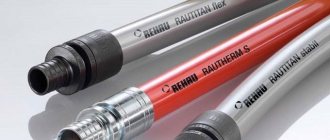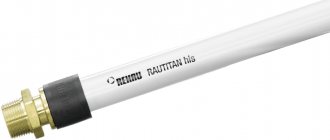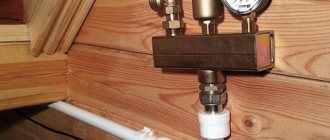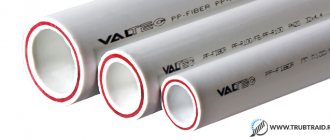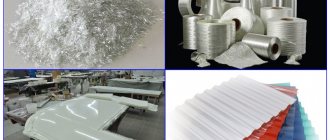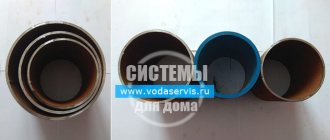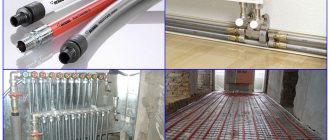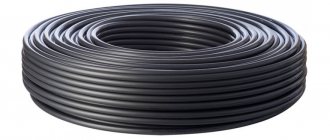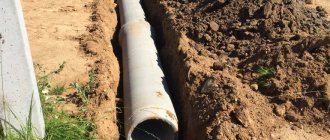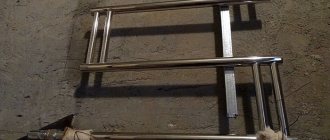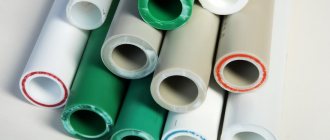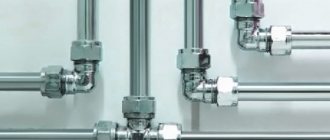Rehau water supply and heating pipes made of cross-linked polyethylene are relatively new and unfamiliar to a wide audience. They differ from standard polypropylene pipes, which are used in literally every bathroom, not only in material. And also operational properties and installation features. Owners of apartments in which renovation is planned often wonder: Rehau pipes or polypropylene pipes, which is better? We will help you understand and highlight the advantages and disadvantages of each type of pipe.
Polypropylene pipes general information
Different types of material are used for cold and hot water. The fact is that ordinary polypropylene is not intended for high-temperature liquids, therefore, to prevent it from melting, it is additionally reinforced with aluminum or fiberglass. Such reinforced pipes are called reinforced and designated as D25, and simple pipes, unreinforced, respectively, D20, where D is the diameter. As you can see, about 5 mm is spent on reinforcement, and it must be taken into account that this procedure only increases the heat resistance of the pipe, but does not in any way affect its mechanical strength.
Polypropylene - production, application
It began to be synthesized in Russia in the 80s of the last century. Production volumes of domestic polypropylene (hereinafter referred to as PP) from 2010 to 2021 increased almost 2 times.
The popularity of polypropylene is due to its versatility of use and ease of processing. It is used to make pipes, dishes, film, insulation, containers, glue, putty, equipment parts, and much more. It replaces wood, glass, metal, paper, textiles.
Polypropylene (PP marking) is the result of the polymerization of propylene using catalysts . It is initially available in the form of white powder or granules. Then goods are produced from it using various technologies, adding dyes and stabilizers to impart the necessary properties.
Advantages
- The biggest advantage of this material is its low cost. In the Moscow region, the average price for polypropylene pipes is 60 rubles per meter, and corners cost about 20. However, despite this, end switches intended for threaded connection of pipes with metal elements are sold more expensively - 150 rubles per piece, so if in the system has many metal-plastic transitions, repairs can hit your pocket hard.
- Also a plus is the relatively simple installation. To connect a polypropylene pipe with a corner, you just need to insert them into each other and solder them - a procedure that is accessible even to a child.
Briefly about country irrigation systems
Irrigation of beds and fruit trees in the country using pipes can be organized in several ways. When choosing one system or another, you need to take into account the type of soil on the site, general climatic conditions and the desire (or unwillingness) to spend time watering the garden.
The manual method of moistening the soil is too labor-intensive. A country house is intended for relaxation. Often, city residents go to it on weekends to work there by the sweat of their brow. There are those who even really like this pastime.
But most just want to relax outside the city. However, almost everyone has a small vegetable garden, apple trees and currants in their dacha. And they need to be watered.
All artificial irrigation systems for a summer cottage are divided into two types: automatic and semi-automatic - the first imply transferring control over the watering process completely to automation, and the second involve partial human participation
Based on the method of water supply, there are three types of non-manual irrigation systems:
- Drip surface.
- Subsurface.
- Sprinkling (sprinkling).
The technology for creating “artificial rain” is the most common. To install such a system in a summer cottage, it is necessary to install several rotary sprinklers and connect water pipes to them. However, such sprinklers waste too much water.
Some of it simply evaporates before reaching the soil. This type of country irrigation is mainly intended for watering large lawns.
Two other options for automatic watering systems involve supplying moisture to or onto the soil directly next to the plant being watered. For this purpose, perforated pipes, droppers and bubblers are used. This method of irrigation is more economical in terms of water consumption, but due to the large length of water pipelines it is more expensive to install.
For an underground irrigation system, a perforated pipeline will have to be buried in the ground at a depth of 20–30 cm, but for a surface pipe it can be laid on the ground
You will find all the details about choosing pipes for drip irrigation in the article devoted to this interesting issue.
Pipes for all types of garden watering are selected according to diameter in the range from 25 to 32 mm. If the pressure in the central water supply at the dacha is low or water is supplied to the system from the tank by gravity, then the cross-section should be closer to the upper limit. Otherwise, you can save money by taking pipes and fittings with a diameter of 25–27 mm.
With smaller values, the pipeline will work ineffectively, watering the ground for too long. And with large sizes it will turn out to be an unnecessarily expensive pleasure. The flow of water will still only fill such a pipe halfway. And large-diameter pipe products are obviously more expensive than their thinner counterparts.
The rules and guidelines for choosing a hose for watering cultivated plants and green spaces in a summer cottage are set out in the article, which we recommend reading.
Flaws
- The main disadvantage is that the pipe has virtually no flexibility. This is especially disadvantageous if, for example, you need to assemble a complex curved line - you will need a large number of corners, which means you will have to do a lot of welding.
- Polypropylene pipes are quite bulky. To provide them with strength and a certain rigidity, it is necessary to make a large diameter, 20-25 mm. But such a pipe, of course, cannot withstand high pressure.
- "Human factor". If the installer does not pay attention during soldering, or a low-quality soldering machine is used, in general, if the person assembling the pipes somehow makes a mistake, the system may leak.
Rehau cross-linked polyethylene pipes
This is a relatively new and very popular development among middle- and high-income customers. These pipes, marked with the abbreviation PEX (read: PECS), are made from a special modified form of polyethylene, which is called cross-linked. The crosslinking process is quite complicated, so it is only worth saying that as a result the material acquires increased temperature resistance, that is, it does not melt under the influence of hot environments.
There are 3 types of PEX pipes, distinguished by heat resistance - these are PEX-a, PEX-b and PEX-c. The first are the best, since they have a higher degree of cross-linking, the second are average, the third are suitable only for low-power water supply systems, and they usually do not last long.
Internal differences
Let's try to understand the differences in the properties of cross-linked polyethylene and polypropylene by turning to the features of their structure:
- PEX polyethylene is produced by cross-linking linear macromolecules of polymerized ethylene to obtain a three-dimensional mesh-cellular structure:
- The strong intermolecular bonds formed in this process give the material high resistance to mechanical, chemical and thermal loads.
- Such connections, even at the casting stage of the product, give it a shape that will then be very difficult to change.
- PEX is the densest of all types of polyethylene with a rating of 940 kg/m3.
- Polypropylene is a polymer of propylene hydrocarbon that has an unstable crystalline structure, which gives it both high tensile and tensile strength and high ductility. He:
- There can be three types depending on the spatial direction of the branches of the molecules (methyl groups),
- It has a “breathing” structure that can allow gaseous substances to pass through,
- It is a much less dense material than any other type of plastic, with a density ranging from 850 to 900 kg/m3.
Advantages
- PEX pipes have a significant advantage over polypropylene pipes - they can bend and keep their shape. This greatly simplifies their installation, especially in geometrically complex systems. But there is also a type of non-plastic PEX that, with any bending, immediately returns to its original form. Such pipes are cheaper, but if you need to make an angle, they have to be fixed with special fasteners. The first ones are marked as FLEX (read as flex), and the second ones Stabil (stable).
- They can withstand quite high temperatures - up to 95 degrees.
- A lower diameter than that of polypropylene pipes - the water flow rate and pressure that the PLP pipe can withstand with a diameter of 25 mm, PEX duplicates with a diameter of only 16.
- Simple installation, without the so-called “human factor”. To connect two sections of the pipeline, you just need to crimp the ring with pliers and twist it until it stops. That is, it is basically impossible to make a mistake here that could lead to a leak.
Properties of PP and PEX
Strength
The strength characteristics of these two materials are approximately equal; their elongation to the limiting position (rupture) ranges from 250 to 800%. But at the same time:
- Polypropylene is more resistant to cracking, even when exposed to possible adverse factors,
- Cross-linked polyethylene is more durable under sudden load changes: increasing the stretching rate significantly reduces the mechanical properties of PP.
Temperature resistance
The maximum operating temperatures for products made from both plastics do not exceed 140 0C, but they melt and burn at slightly different temperature conditions:
- PP melts at t0=176 0C,
- PEX – at t0 from 190 to 200 0C.
But the “lower” limit for the use of materials is very different. If cross-linked polyethylene retains its strength and elastic properties down to -50 0C, then polypropylene becomes brittle already at -15 0C (for some modifications even at -5 0C).
INTERESTING! Cross-linked polyethylene is more resistant to temporary increases in temperatures to very high values, and polypropylene is a material of long-term durability. This means that low-temperature heating systems with the possibility of sudden temperature changes are better made from PEX, and constantly hot pipelines will last longer from PP.
Chemical properties
Chemically, polypropylene is inferior to cross-linked polyethylene:
- Its resistance to organic and inorganic reagents and solvents, although high compared to non-polymer materials, is weaker than that of PEX.
- Resistance to environmental phenomena is also much lower: in its pure form it ages much faster under the influence of atmospheric oxygen and sunlight, especially when temperatures rise.
ATTENTION! To increase the service life of PP polymers, stabilizers are added to raw materials at the production stage of products, improving resistance to ultraviolet radiation and oxygen, and PEX pipes usually have a protective anti-diffusion coating.
Physical properties
Despite its significantly higher density than polypropylene and almost similar fluidity, PEX is a softer material and also has the following capabilities:
- Due to its high density, it does not allow liquids and even gases to pass through, which makes it possible to make safe pressure gas pipelines and technical pipelines from it,
- Thanks to its elasticity, pipes made from it bend much better with the formation of sharper turns, due to which a much better contour for underfloor heating systems is obtained from cross-linked polyethylene.
